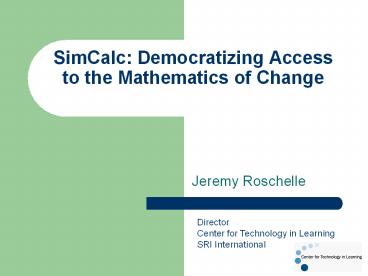SimCalc: Democratizing Access to the Mathematics of Change PowerPoint PPT Presentation
Title: SimCalc: Democratizing Access to the Mathematics of Change
1
SimCalc Democratizing Access to the Mathematics
of Change
- Jeremy Roschelle
DirectorCenter for Technology in LearningSRI
International
2
Pop Quiz
- Over the past 20 years, mathematics achievement
of US 8th graders has been - Improving?
- Declining?
- Staying the Same?
3
Results from NAEPImproving but not fast enough
Average mathematics scale scores, grades 4 and 8
19902003
At least a grade level of improvement since
1996 -- Judy Sowder
But most students still at the basic level.
Unlikely to hit national goal by 2014 of all
proficient.
4
What NAEP Tells Us
- We need to accelerate improvement.
- Engage more students in complex and conceptually
difficult math not just the basics
5
The Challenge
6
The economy is going down
7
Which plan to reduce the budget deficit to zero
saves the taxpayers the most money?
Deficit spending per month
years
Most calculus undergrads are perplexed!
8
- Democratizing access to the mathematics of
change - i.e., rate, accumulation, proportionality,
slope - for kids who never make it to H.S. Calculus
- WHY?
Change is the central 21st century
phenomena. Every citizen needs accessto the
mathematical fundamentalsof change!
9
Pop Quiz 2
- Which factors correlate with high 8th grade
scores? - Use of computers
- Use of graphing calculators
- Solving problems from the textbook
10
More results from NAEP
- Which factors correlate with high 8th grade
scores? - ? Use of computers
- ? Use of graphing calculators
- ? Solving problems from the textbook
11
- Today, Two Main Points
- Our Core Design Approach
- Restructuring Knowing
- Our Research Program on Scaling Up
- Cheaper Platform
- Coverage of Curriculum
- Diversity of Users
12
Our Design ApproachRestructuring Knowing
13
Our big representational move
Algebra
Graphs
Tables
14
Our big representational move
? Learners ? Technology ? Curriculum
Algebra
Motion Phenomena
Graphs
Tables
15
DEMO
16
Demo Recap
Rep. Tech.
Learners
- Edit Graphs
- Link Reps
- Piecewise
- Animation
- Motion
- Graphs
- Intervals
- Counting
- Historical roots in motion
- Graphs before symbols
- PW before Continuous
Math
17
Our Research Approach
- Over 10 years, our research has been about
scaling - From students to teachers to schools
- From expensive to cheaper devices
- From calculus to core middle school math
- Across demographic settings
- Across grade levels
18
Our Research Approach
- For todays talk, only
- Diverse Students
- Devices
- Wide Variety of Teachers
- Connecivity
19
Diverse students
- We have field tested primarily in disadvantaged
settings in Newark, NJ San Diego Syracuse
Boston Fall River, MA - But also Portola Valley, CA
- 7th, 8th, 9th, 11th, Freshman grade levels
20
VIDEO
21
Diverse Teachers
- Can a wide variety of teachers effectively use
SimCalc given a limited amount of training?
22
The Study
- Randomized, Controlled Experiment
- 2-3 week Replacement Unit
- Outcome measure used both more basic and more
conceptually difficult items - Pilot in 2003-4 (23 teachers)
- Experiment in 2005-7 (140 teachers)
23
The Study - Topic
- Proportionality in 7th Grade
- Highlights more conceptually rich approach
- Beginnings of the pathway to Algebra Calculus
- Central 7th Grade Topic
- Texas had a strong course existingthat we could
use as control
24
Findings
- Stronger Gains for SimCalc
25
Findings
- Gains in
- Every Quartile
26
Findings
- Wide Variation
- Across Teachers
27
Puzzle for future research
- Why do teachers get stronger student gains?
- Not traditional or reform style
- Not length of time
- Not our impression of the teachers
- Hypothesis great teachers focus interaction on
supporting students to do the conceptually
challenging parts
28
Diverse Devices
- Calculators are ubiquitous, affordable
- 11 Access enables frequent, integral use
29
Example Match My Graph
30
Did Students Learn?
- Significant pre- to post-test gains on a test of
mathematics of change concepts - t(24) 16.11 p lt .001.
31
Did Students Learn?
- Students performed well on revised AP calculus
exam questions. Example (results on next page)
1. At what value of s does the bug change
direction? (A) 2 (B) 4 (C) 6 (D) 7 (E)
8
2. What is the total distance the bug traveled
from s 0 to s 8 ? (A) 14 (B) 13 (C)
11 (D) 8 (E) 6
A bug begins to crawl up a vertical wire at time
s 0. The velocity v of the bug at time s, 0
s 8, is given by the function whose graph is
shown above.
32
Did Students Learn?
NetCalc student performance compared to AP
High School student performance (AP Results from
The College Board, 1999).
33
Connectivity
34
The Response System
Students respond individually
Teacher presents question
Instant histogram results
35
1. Extends to Images
36
2. Extends to Text
37
3. Extends to mathematics
Kaput Hegedus
From simple contributionsof each student (make a
fn that goes throughthe point 6,4) To full
class discussionof a more complex
concept (characteristics of a family of functions)
38
4. Extends to participatory simulations
Stroup and Wilensky
Make your y value twice your x value
39
About SRI Internationals Center for Technology
in Learning
- We have 60 Learning Scientists and staff working
on three intertwined lines of work - Improving K-12 math science teaching and
learning (NSF) - Conducting large scale evaluations (Gates, Dept
of Ed) - Consulting on product innovation (Texas
Instruments, Intel, Palm)
40
Conclusion
cognition,epistemology
dynamic representation
Computation
Learning
41
Conclusion
cognition,epistemology
dynamic representation
Computation
Learning
discourse,participation
42
Conclusion
cognition,epistemology
dynamic representation
Computation
Learning
discourse,participation
dynamiccoordination
43
URLs
- SRIs Center for Technology in Learningctl.sri.co
m - IEEE Wireless Mobile Technologies in Education
in Japan in December.Google wmte 2005 - ICCE in Singapore in DecemberGoogle icce 2005
singapore - MLearn conferenceGoogle Mlearn 2005

